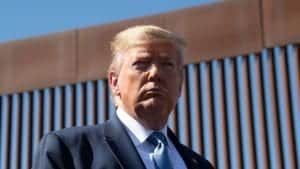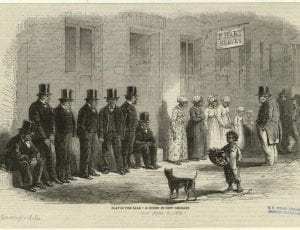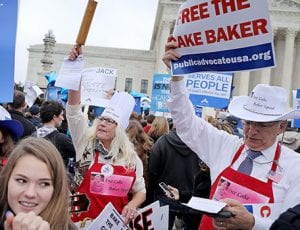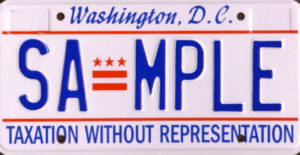The 2020 United States Presidential election is on Tuesday, November 3, and there are 20+ Democrats who have announced their campaign to run. As promised in our earlier post (found here), this post will be the first of several where we take a closer look at a few candidates—who they are and their stances are on some of the issues they prioritize. We will be going in order by candidacy announcement date.
Most of the information will come from the candidates’ own campaign sites, as the point of these posts is to give readers an idea of what each candidate’s platform is and how the candidates are presenting themselves to voters.
This post will include a closer look at some lesser known, but early announcing, candidates: John Delaney, Andrew Yang, and Tulsi Gabbard.
Candidate: Former Representative John Delaney, D-Md.
Slogan: Focus on the Future
Short Bio (excerpted from campaign site):
John Delaney’s grandparents came to the United States from Ireland and England, and found jobs in Jersey City, N.J., where one grandfather worked in a pencil factory and the other was a dockworker. He grew up in a blue-collar family in Wood-Ridge, New Jersey. With help from his father’s labor union, he was able to attend and graduate from Columbia University and Georgetown University Law Center. After law school, he decided to take a chance and start his own businesses. By 40, he had launched and led two companies that created thousands of jobs and were publicly traded on the New York Stock Exchange. He was the youngest CEO on the NYSE with his first company. In 2004, he was named an Ernst & Young Entrepreneur of the Year, and his businesses were voted to be among the best places to work. He was also the only former CEO of a publicly traded company serving in the House of Representatives during his three terms. In 2012, he took congressional office serving the Sixth District of Maryland and since then has introduced large-scale bipartisan legislation on infrastructure, tax reform, social security, and impact investing. On foreign policy, his work has centered on a strong national defense, strengthening alliances, and cutting sources of terrorism funding. He believes that the best policymaking focuses squarely on the future and gives that as the reason for founding the Artificial Intelligence Caucus and helping found the bipartisan Climate Solutions Caucus. In 2017, he was named to Fortune’s list of the “World’s 50 Greatest Leaders.” He says that his campaign commitments are the same as they were when he first ran for Congress: advance progressive values, find solutions and common ground, bring new ideas, and create forward-looking policies that help everyday Americans.
| Issue: |
Candidate’s Stance According to Campaign Site: |
A National AI Strategy
Learn more |
The United States must create a government strategy that will provide the tools and skills needed for the country to win the international AI race. For that to occur, the United States must prioritize resources to eliminate gaps in national abilities compared to other high-tech countries, invest in areas of research that deserve additional funding, develop incentives for high-tech professionals to work for the government, support an immigration system that values high-tech professionals, and crack down on international intellectual property (IP) theft. |
Climate Change and Climate Corps
Learn more |
Delaney proposes a $4 trillion climate change plan—a comprehensive roadmap of policy solutions to address the climate change crisis by focusing on six areas: A carbon fee and dividend direct air capture/negative emissions technology (NET); increasing the renewable energy research budget five-fold; challenge grants; a climate corps; and a carbon throughway. Most notably, Delaney proposes the creation of the Climate Corps as part of his National Service Program. The new program would provide opportunities for recent high school graduates to work in low-income urban and rural communities where Corps members would support these communities’ transition to a green economy, work on environmentally friendly projects, and fight climate change by working on the ground. |
Department of Cybersecurity
Learn more |
In response to the terrorist attacks of September 11, 2001, the government created the Department of Homeland Security. In response to continued cyber attacks, Delaney wants to create a Department of Cybersecurity with a sole focus on coordinating and implementing U.S. cybersecurity strategy, led by a cabinet-level secretary. |
Other Issues
Learn more |
Delaney has addressed 18 other issue areas in detail on his campaign site. Visit his site to further research his platform: John Delaney’s Policy Platform |
Candidate: Attorney and entrepreneur Andrew Yang
Campaign Slogans: Humanity First; Make America Think Harder (Math); Not Left, Not Right, Forward
Short Bio (excerpted from campaign site):
Andrew Yang was born in upstate New York in 1975. His parents immigrated from Taiwan in the 1960s and met in graduate school. His dad was a researcher at IBM who generated 69 patents in his career, and his mom was the systems administrator at a local university. He studied economics and political science at Brown and went to law school at Columbia. After a brief stint as a corporate lawyer, Yang ran a national education company that grew to become a national leader. His education company was acquired, and he decided to take the earnings and commit to creating jobs in cities hit hard by the financial crisis. By that time, Yang says he understood the power of entrepreneurship to generate economic growth, so he founded Venture for America, an organization that helps entrepreneurs create jobs in cities like Baltimore, Detroit, Pittsburgh, and Cleveland. In its first year, VFA trained 40 fellows; by 2017, more than 500 VFA fellows and alumni had launched dozens of companies and helped create over 2,500 jobs across the country. Yang received several awards from the Obama White House, being named a Champion of Change in 2012 and a Presidential Ambassador for Global Entrepreneurship in 2015. He believes that VFA resonates with so many people because it’s clear that there’s a growing problem in the United States: automation is destroying jobs and entire regions are being left behind. He says that together we can build a new type of economy: one that puts people first.
| Issue: |
Candidate’s Stance According to Campaign Site: |
Universal Basic Income (UBI)
Learn More |
The most direct and concrete way for the government to improve your life is to send you a check for $1,000 every month and let you spend it in whatever manner will benefit you the most. The government is not capable of a lot of things, but it is capable of sending large numbers of checks to large numbers of people promptly and reliably. The United States has plenty of resources; they’re just not being distributed to enough people right now. As president, Yang will implement the Freedom Dividend, providing universal basic income (UBI) of $1,000/month to all American adults over the age of 18 so that we may all share in the prosperity we have contributed to and participate in the new economy. UBI is a version of Social Security in which all citizens receive a set amount of money per month, independent of their work status or income. Everyone from a hedge fund billionaire in New York to an impoverished single mom in West Virginia would receive a monthly check of $1,000. If someone is working as a waitress or a construction worker making $18,000 a year, he or she would essentially be making $30,000 with UBI. UBI eliminates the disincentive to work that most people find troubling about traditional welfare programs—if you work, you could actually start saving and get ahead. With the growing threat of automation, the concept has gained renewed attention, with trials being run in Oakland, Canada, and Finland as well as in India and other parts of the developing world. Today, people tend to associate UBI with technology utopians. But a form of UBI almost became law in the United States in 1970 and 1971, passing the House of Representatives twice before stalling in the Senate.
|
Medicare for All
Learn More |
Health care should be a basic right for all Americans. Right now, if you get sick, you have two things to worry about—how to get better and how to pay for it. Too many Americans are making terrible, impossible choices between paying for health care and other needs. Yang wants to provide high-quality health care to all Americans and believes that a Medicare for All system is the most efficient way to accomplish that. He believes such a system would be a massive boost to the economy, as people will be able to start businesses and change jobs without fear of losing their health insurance. In addition to creating a Medicare for All system, Yangs wants to shift the way doctors are compensated to promote holistic and empathic care and create incentives for, and invest in, innovative treatment methods and methodologies.
|
Human-Centered Capitalism
Learn More |
Americans need to make the markets serve them rather than the other way around. Profit-seeking companies are organized to maximize their bottom line at every turn, which will naturally lead to extreme policies and outcomes. Americans need government leaders who are truly laser-focused on the public interest above all else and will lead companies to act accordingly. As president, Yang will change the way the United States measures the economy, from GDP and the stock market to a more inclusive set of measurements that ensures humans are thriving, not barely making it by. New measurements like median income and standard of living, health-adjusted life expectancy, mental health, childhood success rates, social and economic mobility, absence of substance abuse, and other measurements will give Americans a much clearer and more powerful sense of how they are doing both individually and as a society. Yang also wants to rein in corporate excesses by appointing regulators who are paid a lot of money—competitive with senior jobs in the private sector—but then will be prohibited from going to private industry afterward. Regulators need to be focused on making the right decisions and policies for the public with zero concern for their next position. The government’s goal should be to drive individuals and organizations to find new ways to improve the standards of living of individuals and families on these dimensions. In order to spur development, the government should issue a new currency—the Digital Social Credit—which can be converted into dollars and used to reward people and organizations who drive significant social value. This new currency would allow people to measure the amount of good that they have done through various programs and actions.
|
| Other Issues: |
Yang has addressed 104 issue areas in detail on his campaign site. Visit his site to further research his platform: Andrew Yang’s Policy Platform |
Candidate: Representative Tulsi Gabbard, D-Hawaii
Campaign Slogan: Lead with Love
Short Bio (excerpted from campaign site):
Polynesian-Caucasian, Tulsi Gabbard was born in 1981 in Leloaloa, American Samoa, the fourth of five children born to Carol and State Senator Mike Gabbard. She grew up in Hawaii after moving there at two years old. Gabbard graduated from Hawaii Pacific University with a degree in International Business. At the age of 19, she co-founded Healthy Hawaii Coalition (HHC), a nonprofit grassroots organization whose mission is to protect the environment and improve individual and community health. In 2002, at 21 years old, she became the youngest person ever elected to the Hawaii State Legislature, where she served on the Education, Higher Education, Tourism, and Economic Development Committees. In 2004, when Gabbard’s fellow soldiers from the 29th Brigade were called to war in Iraq, she volunteered to join them. In 2006, she went to Washington, D.C., to serve in the Senate as a legislative aide to Senator Daniel K. Akaka, D-Hawaii. There, she advised Senator Akaka on issues relating to energy independence, homeland security, the environment, and veterans affairs. After returning home from her second deployment to the Middle East in 2009, Gabbard offered to serve on the Honolulu City Council and was elected on November 3, 2010. She served as chairperson of the Safety, Economic Development, and Government Affairs Committee, as vice chair of the Budget Committee, and as a member of the Zoning and Public Works Committee. In 2012, Gabbard ran for the House of Representatives for Hawaii’s Second Congressional District and defeated the former mayor of Honolulu in an upset victory in the Democratic primary. She went on to win the general election. When she took office in 2013, she became one of only two female combat veterans in the House and the first American Hindu ever elected to Congress.
| Issue: |
Candidate’s Stance According to Campaign Site: |
The War on Terror
Learn More |
To defeat ISIS and other jihadist groups that have declared war on the United States, Gabbard believes the United States must do four things: Immediately end the illegal and counterproductive war to overthrow the Syrian government of Bashar al-Assad; defeat ISIS militarily; find a political solution; and defeat ISIS and other Islamist militants ideologically.
|
Universal Healthcare
Learn More |
Gabbard believes that our present health care system is organized for the benefit of big insurance and pharmaceutical companies, and not for the American people. While the Affordable Care Act was a step in the right direction, many issues remain with it, including escalating costs and high copayments/deductibles. Most importantly, 27 million Americans are still uninsured. All Americans should have access to affordable health care through Medicare or a public option. Gabbard believes we must ensure universal health care and empower the government to negotiate with pharmaceutical companies to bring down the price of prescription drugs.
|
Campaign Finance Reform
Learn More |
Gabbard is committed to campaign finance reform, taking big-money superPACs out of politics, and empowering the people and their voices in our democracy. Some ways she suggests doing this include: Fighting to establish a system to provide public funds that will amplify small donations to federal candidates who agree to lower contribution limits, working to reduce barriers to the ballot box and increase turnout, supporting meaningful contribution limits so a wealthy few cannot use their economic power to shut out ordinary citizens, and working to strengthen disclosure requirements for outside groups.
|
| Other Issues: |
Gabbard has addressed several other issue areas on her old campaign site (from her run for Congress). So, until her presidential site is updated, visit this site to further research her policy ideas: Tulsi Gabbard on the Issues (Congressional Election Site)
|
Discussion Questions
- Had you heard of any of these candidates prior to reading this? If not, why might that be? If so, in what context had you heard about them? If not, why might that be?
- Looking at this list, do you notice anything interesting about the candidates? Are there any noticeable trends in their platforms, backgrounds, campaign language, stances on issues, etc.?
- Are there any candidates from this list who immediately jump out at you as someone you agree with on any specific issues?
- Of the candidates listed here, are there any that you think would have a chance of winning the Democratic nomination? Or a chance of defeating President Donald Trump? Why or why not?
- Imagine that a less well-known candidate (like one of the three above) won the Democratic nomination. Do you think choosing a relatively unknown candidate to face President Trump would be a good or bad strategy for the Democratic Party? Why?
Sources
Featured Image: WhiteHouse.gov
 Immigration policy and enforcement continues to be a major area of conflict between Democrats and Republicans. Currently, Congress is considering many bills related to immigration, asylum, migrant detention, and family separation. This week, we will look at two proposals that Republicans are advancing; two weeks ago, we examined two bills that Democrats are advancing.
Immigration policy and enforcement continues to be a major area of conflict between Democrats and Republicans. Currently, Congress is considering many bills related to immigration, asylum, migrant detention, and family separation. This week, we will look at two proposals that Republicans are advancing; two weeks ago, we examined two bills that Democrats are advancing.
 In January 2019, Representative Sheila Jackson Lee (D-Texas) introduced H.R. 40: The Commission to Study and Develop Reparations Proposals for African Americans Act.1 Reparations for slavery, Jim Crow, and systematic segregation and racism in major U.S. institutions is not a new idea, but it has never gained the type of traction that it currently has. In June, the House Judiciary Committee held hearings to begin exploring the idea.2
In January 2019, Representative Sheila Jackson Lee (D-Texas) introduced H.R. 40: The Commission to Study and Develop Reparations Proposals for African Americans Act.1 Reparations for slavery, Jim Crow, and systematic segregation and racism in major U.S. institutions is not a new idea, but it has never gained the type of traction that it currently has. In June, the House Judiciary Committee held hearings to begin exploring the idea.2 On August 15, the Department of Labor published proposed changes that would expand federal contractors’ ability to claim a religious exemption to equal opportunity and anti-discrimination rules.1 The proposed rule change, as written, could allow employers with federal contracts to fire or refuse to hire LGBTQ employees, and could even be used to fire unmarried pregnant women if an employer claimed that it was against their religion to support having sex out of wedlock.
On August 15, the Department of Labor published proposed changes that would expand federal contractors’ ability to claim a religious exemption to equal opportunity and anti-discrimination rules.1 The proposed rule change, as written, could allow employers with federal contracts to fire or refuse to hire LGBTQ employees, and could even be used to fire unmarried pregnant women if an employer claimed that it was against their religion to support having sex out of wedlock. If you visit Washington, DC, one of the things you may notice is the license plates on local vehicles.
If you visit Washington, DC, one of the things you may notice is the license plates on local vehicles.






